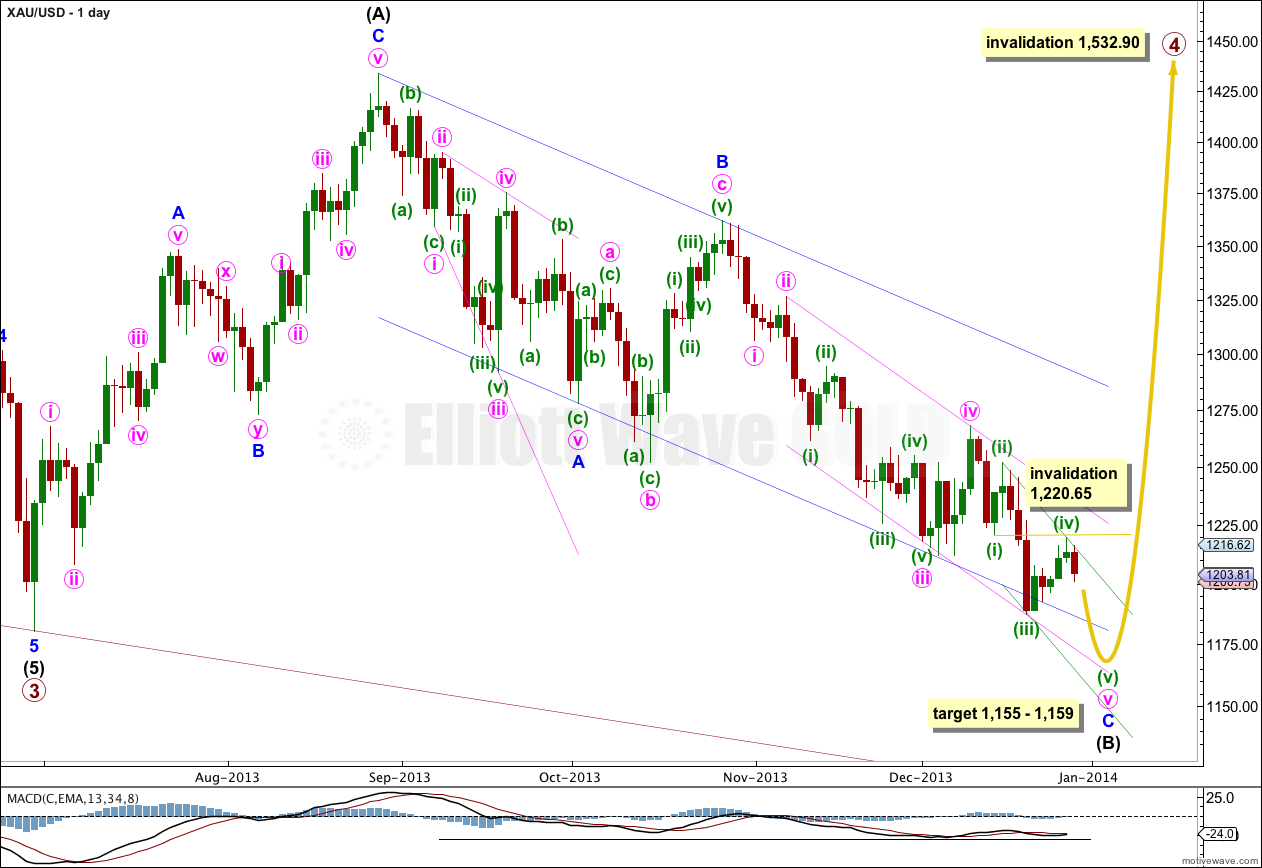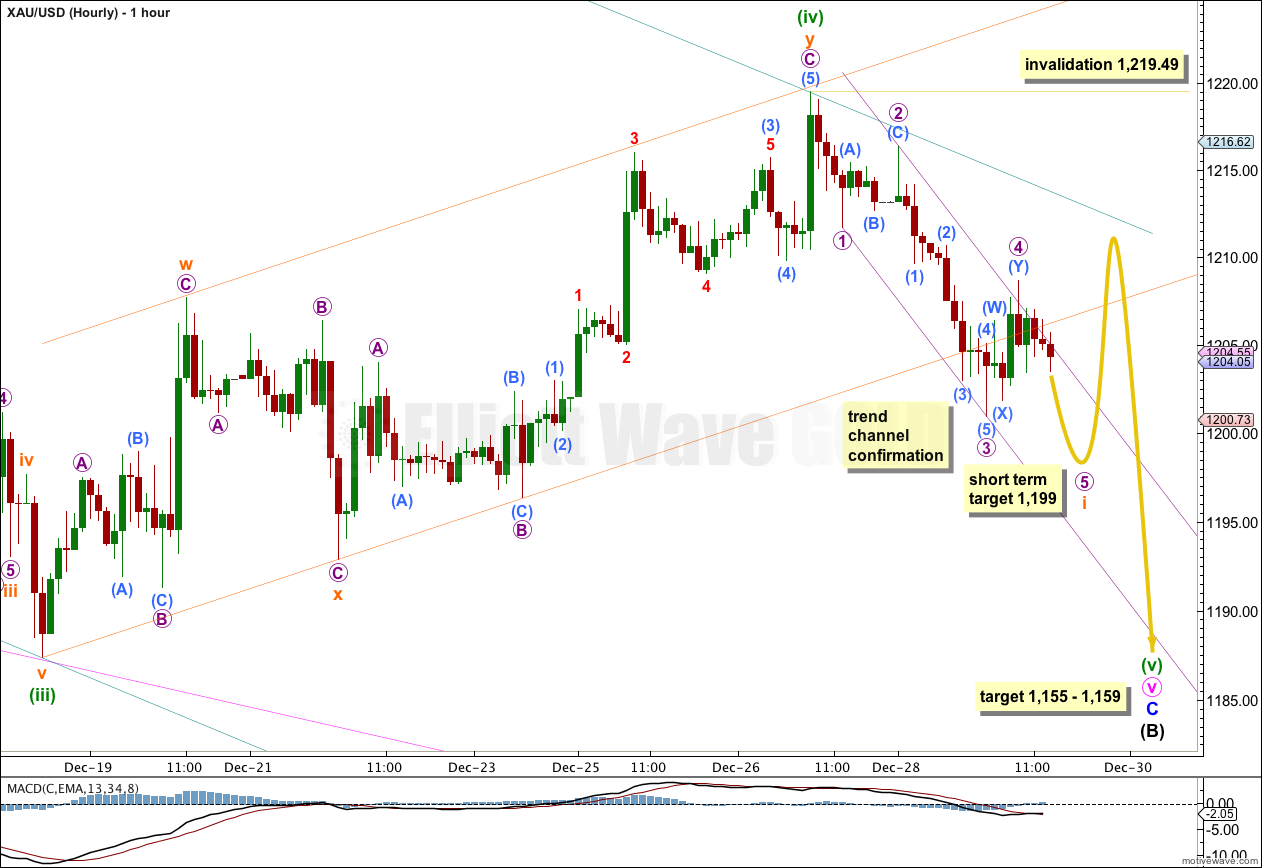The main hourly wave count for last analysis expected downwards movement to begin the new trading week which is exactly what happened. This main wave count had a higher probability than the alternate. This main wave count still has a higher probability, and I will only use the alternate if the main wave count is invalidated.
Click on the charts below to enlarge.
Gold is still within a large fourth wave correction at primary wave degree which is incomplete. To see a full explanation of my reasoning for expecting that primary wave 4 is not over and is continuing see this.
Primary wave 2 was a rare running flat correction, and was a deep 68% correction of primary wave 1. In order to show alternation in structure primary wave 4 may be a zigzag, double zigzag, combination, triangle or even an expanded or regular flat. We can rule out a zigzag because the first wave subdivides as a three. This still leaves several structural possibilities.
The downwards wave labeled intermediate wave (B) is now over 90% the length of the upwards wave labeled intermediate wave (A). Primary wave 4 may be a flat correction, but it may also still be a combination or triangle as there are still several different structural possibilities.
At 1,167.73 intermediate wave (B) would be 105% the length of intermediate wave (A), and primary wave 4 may be an expanded flat correction. Expanded flats normally have C waves which move substantially beyond the end of the A wave, and which are often 1.618 and sometimes 2.618 the length of the A wave. If 1,167.73 is reached and passed then the subsequent upwards wave for intermediate wave (C) may reach well above 1,433.83.
Within minor wave C there was no Fibonacci ratio between minute waves iii and i. This makes it more likely we shall see a Fibonacci ratio exhibited between minute wave v and either of i or iii. At 1,159 minute wave v would reach equality in length with minute wave iii. This lower target allows enough room for minute wave v to complete.
Downwards movement has breached the parallel channel drawn about intermediate wave (B) downwards, and it has found support at the next trend line.
Draw a parallel channel about minor wave C downwards (pink channel) with the first trend line from the highs labeled minute waves ii to iv, then place a parallel copy upon the low labeled minute wave iii. Downwards movement is finding support at the lower edge of this channel.
Draw a parallel channel about minute wave v downwards on the daily chart (green channel) and copy it over to the hourly chart. Draw the first trend line from the highs labeled minuette waves (ii) to (iv), then place a parallel copy upon the low labeled minuette wave (iii). If downwards movement breaks through support at the pink trend line, expect the next line of support to be this green trend line.
When the channel about intermediate wave (B) is finally breached by upwards movement then I would consider that final confirmation that intermediate wave (C) is underway.
Primary wave 4 may not move into primary wave 1 price territory. This wave count is invalidated with movement above 1,532.90.
Minuette wave (iv) is over and the trend channel drawn about it is now clearly breached by downwards movement.
So far to the downside there is an incomplete five wave impulse, and subminuette wave i is incomplete. There is no Fibonacci ratio between micro waves 1 and 3 so it is more likely we shall see a Fibonacci ratio between micro wave 5 and either of 1 or 3.
At 1,199 micro wave 5 would reach 0.618 the length of micro wave 3.
Draw a small channel about this new downwards movement using Elliott’s first technique. Draw the first trend line from the lows labeled micro waves 1 to 3, then place a parallel copy upon the high labeled micro wave 2. Micro wave 4 has overshot the channel but price is now moving back into the channel. I would expect micro wave 5 to end either mid way within the channel or to find support at the lower edge.
When this small channel is breached by subsequent upwards movement (after micro wave 5 has unfolded, and whether or not the target is reached) then we shall have trend channel confirmation that subminuette wave i is over. At that stage I would expect upwards movement for a second wave correction. Subminuette wave ii may find resistance at the upper edge of the green channel copied over from the daily chart.
When subminuette wave i is confirmed complete by a channel breach then draw a Fibonacci retracement along its length. Look for subminuette wave ii to end about the 0.382 or 0.618 Fibonacci ratios.
Subminuette wave ii should not show on the daily chart as a green candlestick I. would expect it to be over well within 24 hours, and the next wave down should be a third wave.
Overall I am expecting more downwards movement for another two days.
Subminuette wave ii may not move beyond the start of subminuette wave i. This wave count is invalidated with movement above 1,219.49.
Alternate Daily Wave Count – Triangle.
It is also possible that primary wave 4 may continue as a regular contracting (or barrier) triangle.
A new low below 1,180.40 is also possible for this wave count if the triangle is a running triangle, as about 40% of triangles are.
The expected direction and structure of this next upwards wave is the same, but for this alternate intermediate wave (C) of the triangle may not move beyond the end of intermediate wave (A). The triangle is invalidated with movement above 1,438.83.
The final intermediate wave (E) upwards may not move above the end of intermediate wave (C) for both a contracting and barrier triangle. E waves most commonly end short of the A-C trend line.
All five subwaves of a triangle must divide into corrective structures. If this next upwards movement subdivides as a zigzag which does not make a new high above 1,438.83 then this alternate would be correct.
Triangles take up time and move price sideways. If primary wave 4 unfolds as a triangle then I would expect it to last months rather than weeks.



